
Welcome!
We want your visit to go smoothly—and with as little delay as possible. To do so, please download, print, and fill out our new patient forms, and bring them with you when you come in. Thank you. We look forward to your visit!
New Patient Forms
Adobe Acrobat Reader is required to read and/or print the New Patient Form. If you don't have Adobe Acrobat Reader, you can get it here.
New-Patient Form
“Where science meets beauty.”

News. Info. Social.
Surgical Solutions
Correcting the inevitable signs of aging.
The effects of aging are inevitable. As the years go by, the skin on the face and neck begins to lose its elasticity. Sun, wind, and the pull of gravity all affect the face, resulting in frown lines, wrinkling across the forehead, and an increasing heaviness of the eyebrows and the upper eyelids.
Using his experience and expertise in facial plastic surgery, Dr. Jones will help you determine the best procedures for you to correct the effects of aging.
Schedule a Consultation
To learn more about a specific surgical procedure, click on a topic below.
Nasal Contouring (Rhinoplasty)
What is Rhinoplasty?
Rhinoplasty (plastic surgery of the nose) is the most commonly performed procedure in facial plastic surgery. The name is a blend of the word rhino (nose) and plasty (to mold or shape). The eyes are the focal point of the face; however when the nose has an undesirable appearance, attention is drawn to it. Rhinoplasty is by far the most artistic procedure in facial plastic surgery, and Dr. Jones believes that the ideal outcome in rhinoplasty is a natural-looking nose with balance and harmony, enhancing the beauty of the eyes and lips.
What can Rhinoplasty do for me?
Many undesirable features of the nose may be improved through cosmetic surgery. Noses may be made narrower, straighter, longer, or shorter. Humps may be removed and the shape, size, angle, and definition of the tip of the nose may be altered. Breathing problems, such as those caused by a deviated septum may be corrected at the same time as the cosmetic changes. The art of rhinoplasty is in obtaining the desired changes, while maintaining a natural appearance and function of the nose. Nasal plastic surgery may be performed for strictly cosmetic reasons (cosmetic rhinoplasty), for strictly breathing reasons (functional septoplasty), and more commonly for a combination of both (septorhinoplasty). Rhinoplasty may be performed at any time after facial growth has been completed, age 15-16 for women and age 16-17 for men.
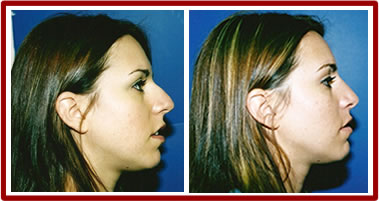
Before
After
Face Lift
A face lift rejuvenates the lower one-third of the face, including the jaw line and neck. It is often combined with facial liposuction, or removal of fat from the lower face and neck to improve the result.
The Procedure
The face lift incision begins in the area of the temple hair, just above and in front of the ear. It continues in front of the ear, around the lobe, up into the crease behind the ear, and then backward into the scalp. No hair is shaved from the incision site. The skin is raised outward before it is repositioned, and the underlying muscle and connective tissue is tightened. Some fat may be removed directly or with liposuction. For men, the incision is aligned to accommodate the natural beard lines. In all cases, the incisions are placed where they will fall in natural skin creases for camouflage. After advancing the skin and trimming the excess, the incisions are closed with fine sutures and/or metal clips. Cords or banding in front of the neck are addressed at the same time through a separate small incision under the chin. Depending on the extent of the surgery, the process can take from two to four hours. Following the surgery, the surgeon will apply a dressing to protect the entire area where the incisions have been made.
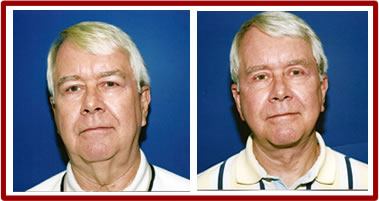
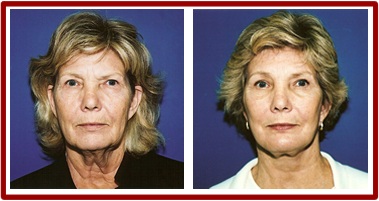
Before
After
Before
After
Endoscopic Forehead Lift
Natural aging can increase the amount of skin between the brow and the upper eyelid lash line. Some people inherit drooping eyebrows called eyebrow ptosis. For this reason, even people in their thirties may have faces that look older than their years. A tired, angry, or sad expression may not reflect how you actually feel. As a result, many people have opted for a procedure known as a forehead lift. A forehead lift elevates the eyebrows and diminishes the wrinkles in the forehead and frown lines between the eyebrows to improve the upper one-third of the face.
What is an Endoscopic Forehead Lift?
An endoscopic forehead lift is a newer less invasive procedure. This technique is similar to the open forehead lift, except that a series of small incisions just behind the hairline are made and an endoscope the size of a drinking straw is used for visualization. The forehead and eyebrows are lifted to reduce the sagging of skin at the eyelid level and the entire area that has been elevated is secured with sutures. The incisions are closed with sutures or metal clips and a bandage is applied. Both open and endoscopic forehead lift procedures typically last about two hours.
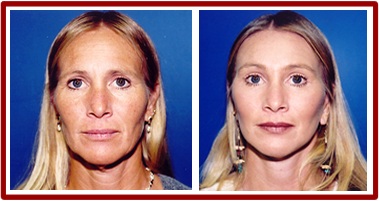
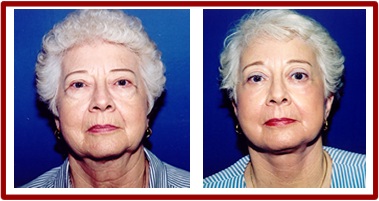
Before
After
Before
After
Mid-Face Lift
A mid-face lift addresses a specific area of the face with less trauma and faster recovery times than a full face lift. For individuals with sagging cheeks but no jowls or banding of the neck, a mid-face lift may be the best solution. Mid-face lifts help individuals to look refreshed and rejuvenated, with results that are more permanent than injectables and more subtle than a traditional face lift. Mid-face lifts target the skin and muscle tissue in the cheeks, tightening and smoothing the appearance. Most persons opting for a mid-face lift are addressing deep marionette lines or nasolabial fold lines.
Procedure
Endoscopic technology is used to perform a mid-face lift, making small incisions above the ear and by the temple. Most patients undergoing a mid-face lift require approximately one week off from work or other regular activities. There is usually minimal bruising associated with a mid-face lift, but some swelling may occur. Using ice for the first twenty-four to forty-eight hours after a mid-face lift can help control swelling.
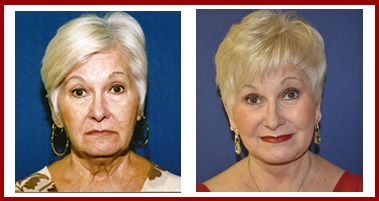
Before
After
Eyelid Surgery (Blepharoplasty)
Eyelid surgery (blepharoplasty) is one of the most commonly performed procedures in facial plastic surgery. Droopy eyelids can make you look older and can also impair vision. Blepharoplasty, performed as a single procedure, corrects these problems and also removes puffiness and bags under the eyes that make you look worn and tired. However, it cannot alter dark circles. Nor does it change sagging eyebrows or remove all fine lines and wrinkles around the eyes. Therefore, Dr. Jones may also recommend a forehead lift or laser skin resurfacing to achieve the best results.
Procedure
In upper eyelid surgery, the incision is made in the existing eyelid crease in order to keep the scars as invisible as possible along this natural fold. Excess fat, muscle and loose skin are removed. Fine sutures are used to close the incision, thereby minimizing the visibility of any scar. In lower eyelid surgery, the incision in this case is made inside the lower eyelid, and excess fatty material is removed. When sutures are used to close this kind of incision, they are invisible to the eye. They are also self-dissolving and leave no visible scar. If excess skin needs to be removed as well, the incision is made in an inconspicuous site just beneath the lashline of the lower lid. Excess skin is removed, and the incision is closed with fine sutures. Under normal conditions, an eyelid lift can cake from one to two hours.
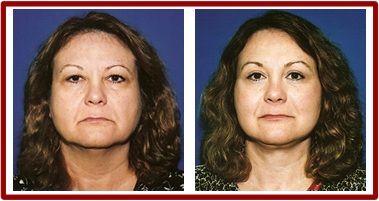
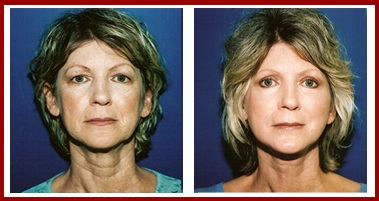
Before
After
Before
After
Chin Augmentation
When people look in the mirror, most focus on the size and shape of their noses, their ears, sagging jowls, or fine wrinkling of the skin. Although few examine their chins with the same discerning eye, the chin is a very important facial feature. A well-defined chin helps balance the face and, along with the nose, largely determines the profile. Surgeons who specialize in rhinoplasty (nasal contouring surgery) are often the first to suggest that changes in chin size or shape may enhance the profile as much as rhinoplasty. Dr. Jones often recommends chin surgery in addition to rhinoplasty when chin augmentation is necessary to achieve facial balance and harmony. Other procedures that may be combined with chin surgery are liposuction (fat removal) of the neck or a face lift to improve the overall appearance of the jaw line and neck. Fortunately this is a relatively straightforward procedure that can make a major difference.
Procedure
To augment the chin, an incision is made either inside the mouth where the gum and lower lip meet or in the natural crease line just under the chin. By gently stretching the tissue, a space is created where an implant can be inserted. The implant, made of synthetic material that feels much like natural tissue normally found in the chin, is available in a wide variety of sizes and shapes. This allows custom fitting of the implant to the configurations of the patient’s face. After implantation, the surgeon uses fine sutures to close the incision. When the incision is inside the mouth, no scarring is visible. If the incision is under the chin, the scar is usually imperceptible. A bandage is then applied which is left in place for about three days.
Cosmetic Ear Surgery (Otoplasty)
Perhaps no other physical characteristic cries out for facial plastic surgery more than protruding ears. Children, long the victims of cruel nicknames such as “Dumbo” or “Mickey Mouse,” are the most likely candidates for cosmetic ear surgery, but this surgery can be performed at any age after the ears have reached full size, usually around five or six years of age. Even if the ears are only mildly distorted, the condition can lead to self-consciousness and poor adaptation at school.
When it comes to otoplasty, conventional wisdom is ‘the earlier the better’ once the cartilages are ready. Adults may also benefit from otoplasty, and often choose this operation in conjunction with other facial plastic surgical procedures. Frequently, adults with protruding ears grow tired of limiting their hairstyles to cover their ears. Not only is it possible to “pin back” ears, but ears can also be reshaped, reduced in size, or made more symmetrical.
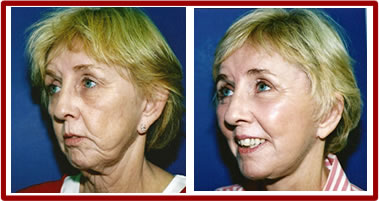
Before
After
Laser Resurfacing
Many environmental factors such as sun exposure, weight gain/loss, stress, cigarette smoke, and alcohol cause changes to occur in the facial skin. These changes result in sagging, fine wrinkles, and pigment changes (splotching). Fine wrinkles are different from sagging skin, and they need to be treated differently.
The most common areas where fine wrinkles develop are around the eyes and mouth. The crepe paper like skin below the eyes and the lines radiating around and into the lips are examples of these. The skin of the cheek may become crisscrossed with wrinkles. The types of wrinkles described above are not removed with lifting surgery such as a face lift, or eyelid lift, but they can be significantly improved with a resurfacing procedure. Resurfacing the skin can also improve acne scarring and irregular pigment.
Procedure
Resurfacing begins by removing the outer layer called the epidermis and part of the dermis. This can be accomplished with deep chemical peels, dermabrasion, or use of a laser. Dr. Jones most often prefers to use the laser because the depth of skin removal can be controlled more precisely. Laser resurfacing may also be safer than chemical peels, which may have systemic side effects. Dermabrasion cannot be used on the fine skin of the eyelids, but the laser can. This is another advantage of using the laser.
The procedure is performed in the operating room under sedation using local anesthesia. The patient’s eyes are protected with shields, and other precautions are taken to prevent accidental injury. The laser settings are adjusted, and multiple passes are made over the treated area, removing deeper and deeper layers of skin. Once the appropriate level is reached, the skin is dressed with ointment. Postoperative care is very important and there are detailed instructions that need to be followed.
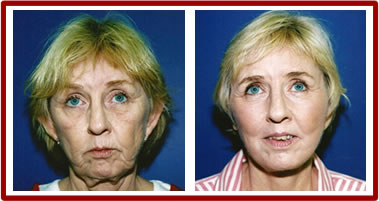
Before
After
Facial Liposuction
Diet and exercise can help many areas of the body, but nothing seems to affect those fatty deposits on your jowl line, or neck. These areas don't usually respond to diet and exercise. Sometimes, even a sensible diet and dedicated exercise routine does not decrease this stubborn fat. Facial liposuction is a safe and reliable method for removing excess fat from the jowl area and neck. In patients under the age of 40, liposuction can be performed by itself. Often a chin implant is also recommended to enhance the result. After 40, the skin may not contract back down well, causing puckering and sagging. This is true whether the fat is removed by liposuction or weight loss. For this reason, a face lift to remove the excess skin is almost always recommended when liposuction is used to remove excess facial fat in patients over the age of 40.
Procedure
Facial liposuction is performed in the operating room. Anesthetic fluid is infiltrated into the fat under pressure to assist in its removal. A small incision is made under the chin and/or in front of the ears. A small, specialized cannula is placed through these incisions and worked through the fat using multiple passes in order to suction out the fat using a vacuum type device. After the desired amount of fat is removed, the chin implant or face lift may be performed, if planned. The incisions are closed with fine sutures and a pressure dressing is applied. Liposuction alone takes an hour or less.
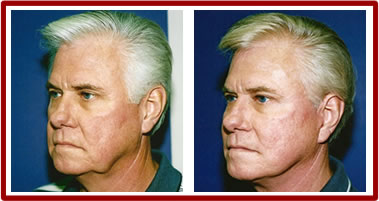
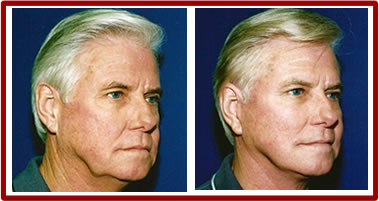
Before
After
Before
After
Fat Transfer
As the face ages, changes occur in the natural supporting structures that result in skin creases and thinning lips. For over a century, filling materials have been injected into the face to raise folds or depressions and enhance the lips. In the past, a bizarre assortment of foreign substances were used including gold, silver, paraffin, sponge rubber, silk, gutta-percha, and ivory, and more recently, silicone. Many of these substances have caused well-publicized complications. The filling materials that Dr. Jones uses have a proven track record for safety and efficacy.
Procedure
Fat transfer may be performed in the office or the Ambulatory Surgery Center. The procedure begins by injecting anesthetic into the face where the fat will be placed and the site where the fat will be harvested, usually the abdomen. Fat is gently harvested through a small skin incision using a specialized cannula into a syringe. The syringe containing the fat and the liquid local anesthetic is centrifuged to separate the fat from the liquid. The purified fat is transferred into 1cc syringes and injected into the lips or other areas on the face for the desired result. Multiple passes are made with specific instruments for proper placement. The entire process may take up to 2 hours, depending on the amount of fat transferred and the number of sites treated.
Facial Reconstruction
Facial reconstruction refers to the use of facial plastic surgery techniques to restore the face as closely as possible to its original state after trauma or the removal of skin cancers. Dr. Jones uses the latest techniques available to perform reconstructive surgeries after trauma or fractures have left the face disfigured. Reconstructive surgery can be beneficial even if the original injury occurred many years ago. He has expertise in treating both functional and cosmetic aspects of facial trauma. Also, unsightly and unwanted scars from trauma can be revised to improve their appearance.
Sun exposure is the major risk factor for the development of skin cancers. Because the face is exposed to the sun as much or more than any area of the body, skin cancers often arise in this location. Dr. Jones can evaluate your face for skin cancer and recommend the appropriate treatment. He works closely with dermatologists to repair facial defects caused by the excision of facial skin cancers. He has extensive training and experience in reconstruction of the nose, ears, face, scalp, and neck. A photo album of previous patients is available in his office that can allow you to appreciate what will be involved in the reconstructive process.
Scar Revision
Scar revision surgery is meant to minimize the scar so that it is more consistent with your surrounding skin tone and texture. Scars are visible signs that remain after a wound has healed. They are unavoidable results of injury or surgery, and their development can be unpredictable. Poor healing may contribute to scars that are obvious, unsightly or disfiguring. Even a wound that heals well can result in a scar that affects your appearance. Scars may be raised or recessed, different in color or texture from surrounding healthy tissue or particularly noticeable due to their size, shape or location.
Your treatment options may vary based on the type and degree of scarring and can include:
• Simple topical treatments.
• Minimally invasive procedures
• Surgical revision with advanced techniques in wound closure
Although scar revision can provide a more pleasing cosmetic result or improve a scar that has healed poorly, a scar cannot be completely erased.
First-class outpatient surgical care.
Dr. Jones performs his operations in the West Florida Medical Center Clinic’s Ambulatory Surgical Center (ASC). Operations are performed on an outpatient basis using either a combination of mild sedatives, local anesthesia, and mild intravenous anesthesia; or general anesthesia.
The ASC has six fully equipped, state-of-the-art operating rooms conveniently located on the first floor of the Surgical Center Building, just below Dr. Jones’s office. This setting provides first-class outpatient surgical care that is both convenient and cost effective. Patients will receive exceptional attention to their individual needs by an experienced and highly skilled staff.
Patient confidentiality is of utmost importance, and the ASC is fully compliant with the newly enacted Health Care Portability and Privacy Act. The ASC is accredited through the Accreditation Association for Ambulatory Health Care, Inc. AAAHC.


